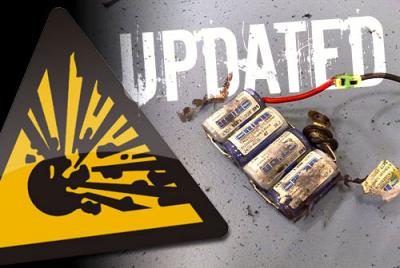Federations react to Exploding cells

Following up on the decision by the Norwegian federation to stop all EP racing until the new year in response to the safety hazard of exploding NiMh cells, a number of other countries have also reacted, however so far not as strictly. Neighbours Sweden decided to just ban a certain batch of the offending IB4200 cells, as have Belgium, and racing will continue as normal, while the BRCA in the UK have advised their members on the best way to handle, use and charge NiMh cells. In the meantime the Intellect Battery Co. have now supplied the batch numbers which may contain cells that could potentially explode when subjected to race type conditions.
Click here to read the list of affected cells and also the BRCA recommendations…
The Intellect Battery Co. have now supplied the following cell Batch No’s., which may contain cells that could explode when subjected to race type conditions :-
ARAET, AZCWT, BNCWT, BNDST, BRAET, BZAWT.
We must stress that the Batch No’s. detailed have been compiled only from returns by European customers to Intellect. There may be other batches that we have not yet been notified of. (So, do not assume that if a Batch No. is not detailed above, that it does not have any problem cells within it). Some EU drivers obtain cells directly from USA, etc. and it is possible that batches outside the EU could also be affected which have not been notified to us.
Intellect supply the same cell in ‘Customer designed shrink’. Intellect has not confirmed if the same Batch Codes are used on these versions of cells. Most of the reports that have been received appear to be relating to cells in the Intellect shrink. Hopefully the above information will cover most of the problems.
No doubt you will have read or heard the stories of batteries exploding and that the Norwegian Federation has temporarily suspended all electric racing. We have been monitoring these incidents but obtaining hard facts is not easy, making it difficult to draw any meaningful conclusions.
Given that there are thousands of cells in circulation, such incidents have been exceedingly rare in the past. The only serious incident that has occurred to date in UK was when a receiver pack blew, that has permanently damaged a person’s eyesight. Although there will have been more injuries caused by scalpels or super glue in eyes than caused from exploding cells, you still need to take care!
The NiMh cells have a chemistry that allows the cell to ‘self-discharge’ over a relatively short period, (days as opposed to weeks). Lately, some of the 4200 cells seem to self-discharge more rapidly than other/previous versions. More importantly the amount each individual cell within a pack discharges varies (i.e. cell 1 might be .9v, cell 2 .8v, cell 3 .9v, cell 4 .7v, etc.)
If charged in this state, some chargers will not know when to stop the charge process, as some cells are demanding to continue with the charge, whilst others could be over charged. It is also important to control the delta peak (voltage drop-off after completed charge) to a low value when charging. Once the cell has achieved full charge, any further charging will produce gas. The cells have a pressure vent, but if that is blocked or not working, the gas pressure could cause an explosion.
High charge rates will also produce more gas and reduce the cells useful life. It is possible that internal gas pressure may cause distortion to some internal parts that could result in a short circuit within the cell. An internal short circuit combined with gas pressure is likely to be a ‘big bang’.
Drivers need to recognise that the ‘matchers’ recommendations are intended to achieve maximum performance. It is the recommendation from the cell manufacturer that should be used.
Best Practice for use of NiMH cells.
1. Equalise cells before charging if they have been stored (with charge) for more than 2/3 days. If any of the cells in the pack show that they do not need to be equalised (i.e. the light does not show or goes out straight away) then remove the pack from the equaliser and charge for a short period (approx. 5 mins. should be adequate). Then carry out the equalising process.
2. Never exceed the manufacturers recommended fast charge rate. This should be 1C max., even if the manufacturer states higher. (C being rate of charge based on capacity of the cell, e.g. a 4200 mAh cell = 4.2 amps)
3. Disregard any charge rate recommendations by the ‘matcher’ if it is more than 1C.
4. Use a maximum Delta-Peak setting of 3mV per cell (6-cell pack = 3mV x 6 = 0.018V).
5. Never repeak cells after main charge.
6. Use a temperature cut-out as an additional safety feature set at 42 deg. C max., located on the hottest cell (usually middle cell). If charging on a cold day then consider reducing this to around 35 deg. C.
7. Allow cells to fully cool to ambient temperature before further charges. Be aware the centre of the cell cools slower than the outer casing. Do not put them in water to cool down; in an emergency cover the cells with a damp/wet cloth if you have to quickly cool them.
8. Store cells with some charge (30/50%).
Source: BRCA [brca.org]




